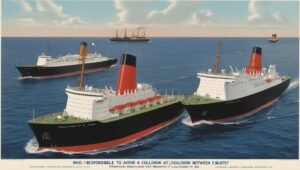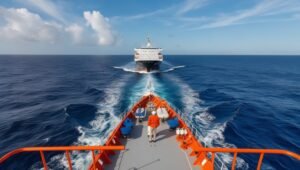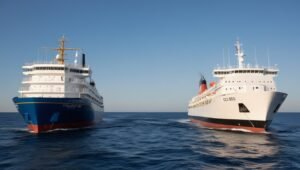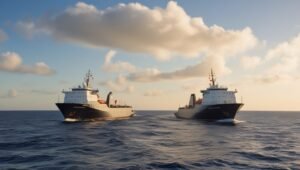
Who is responsible for avoiding a collision between two boats
The obligation to avoid a collision between two vessels falls within the realm of maritime law and is governed by internationally recognized rules, primarily the International Regulations for the Prevention of Collisions at Sea (COLREGs). These regulations establish a comprehensive framework of laws designed to ensure safe navigation and prevent collisions on the water. However, understanding who is responsible for avoiding a collision between two boats involves more than just knowing the rules—it requires seamanship, the specific circumstances of each situation, and the characteristics of each vessel. A deep understanding of staff responsibilities is required.

Introduction to Maritime Collision Avoidance
Collisions at sea can result in loss of life, environmental damage, and financial loss. Thus, collision avoidance rules are strict and universally applicable. COLREGs, established by the International Maritime Organization (IMO), set out the duties and responsibilities of ships to prevent collisions in various situations.
COLREGs apply to the high seas and all waters connected to the sea that are navigable by seagoing vessels. These include rules for the conduct of ships, responsibilities of ships in various situations, signals used by ships to indicate their intentions, and the lights and shapes vessels use to indicate their position. Must show.
General Obligations under COLREGs
The COLREGs outline a number of general principles governing the responsibilities of ships to avoid collisions.
Responsibility states that both the master and crew of the ship are responsible for complying with COLREGs and taking necessary precautions to avoid immediate danger. This rule emphasizes that while the rules provide a framework, staff must always exercise good seamanship.
Lookout Every vessel must keep an adequate lookout to fully assess the situation and risk of collision by sight and hearing as well as by all available means.
Safe Speed Vessels must travel at a safe speed to enable them to take reasonable and effective action to avoid collision and to stop at a distance appropriate to the prevailing conditions.
Risk of collision Every ship must use all available means to determine whether a risk of collision exists. If there is any doubt, the hazard shall be deemed to exist.
Action to Avoid Collision Any action taken to avoid a collision must be positive, taken in sufficient time, and under the observance of good seamanship.

Certain Conditions and Responsibilities
While the general principles provide a broad overview, specific obligations to avoid collisions vary from situation to situation. The COLREGs define “stand-on” and “give-way” vessels, where the stand-on vessel is expected to maintain its course and speed, and the give-way vessel is responsible for taking action to avoid a collision.
Critical Circumstances
In a windward situation, where two power-driven vessels are meeting or are in imminent danger of collision, both vessels are required to alter their course to starboard to pass through the port.
Here the liability is equally shared, as both vessels must take action to avoid collision. However, if one vessel does not take appropriate action, the other must be prepared to take additional steps to avoid a collision.
Conditions of Crossing
When two vessels under power are crossing, and there is a danger of collision, the vessel to starboard off the other (the giving vessel) should keep out of the way and, if possible, Crossing should be avoided. Next to the other vessel. A standing vessel must maintain its course and speed but be prepared to take action if the vessel giving way does not act properly.
In this situation, the primary responsibility rests with the giving vessel, but the bystander also has a responsibility to take action if it becomes clear that the giving vessel is not doing enough to avoid a collision.
Overtaking situations
When one vessel is overtaking another, the overtaking vessel is the giving vessel and the vessel must take action to avoid being overtaken, which is the standing vessel. An overtaking vessel must keep clear until it has completely passed the other vessel.
The overtaking vessel bears the responsibility for avoiding the collision, as it has better control of the situation. An overtaking vessel must maintain its course and speed, although it must also be alert for any danger.
Ships
When two ships approach each other, the responsibilities depend on their relative positions: If each wind is on a different side, the ship must give way with the wind to port.

The character of a good seminary
Beyond specific rules, good workmanship plays an important role in avoiding collisions. This concept involves the exercise of sound judgment, experience, and vigilance. Even when a vessel is a stand-on vessel, its crew cannot depend entirely on another vessel to conduct operations. Staff must constantly monitor the situation and be ready to take action if the situation calls for it.
Good sailing also involves understanding the limitations of one‘s vessel, such as its maneuverability, stopping distance, and the effects of environmental factors such as wind, current, and visibility. Mariners must make informed decisions based on these factors to avoid collisions.
Legal and Ethical Considerations
In the event of a collision, determining fault can be complicated, as it often depends on the specific actions taken by each vessel in the moments leading up to the incident. Courts and maritime authorities will review compliance with COLREGs, crew decisions, and any mitigating circumstances.
Ethically the priority of any ship should always be the safety of life at sea and the protection of the marine environment. This moral obligation transcends legal obligations and underscores the importance of vigilance, proactive measures, and cooperation among ships.
TECHNICAL ASSISTANCE AND THEIR LIMITATIONS
Modern ships are equipped with various technological aids to help avoid collisions, such as radar, Automatic Identification System AIS, and Electronic Chart Display and Information System ECDIS. These tools provide valuable information about other vessels, their courses, and speeds, and can alert the crew to potential collision hazards.
However, these aids should not be relied upon exclusively. Human judgment and good workmanship remain important, as technology can sometimes fail or provide incorrect information. Mariners should use these tools as an alternative to visual and auditory observations.

Conclusion
The responsibility to avoid a collision between two vessels is multifaceted, including adherence to international laws, good seamanship practice, and the use of modern technical assistance. Although the COLREGs provide a clear framework for determining what actions a ship should take in various scenarios, the ultimate responsibility rests with each ship’s crew to navigate safely and avoid collisions. Take all necessary precautions for
Collisions can have catastrophic consequences, and every ship has to understand its responsibilities, maintain vigilance, and take decisive action when the threat of a collision arises. By doing so, they fulfill not only their legal obligations but also their moral duty to protect marine life and the marine environment.
